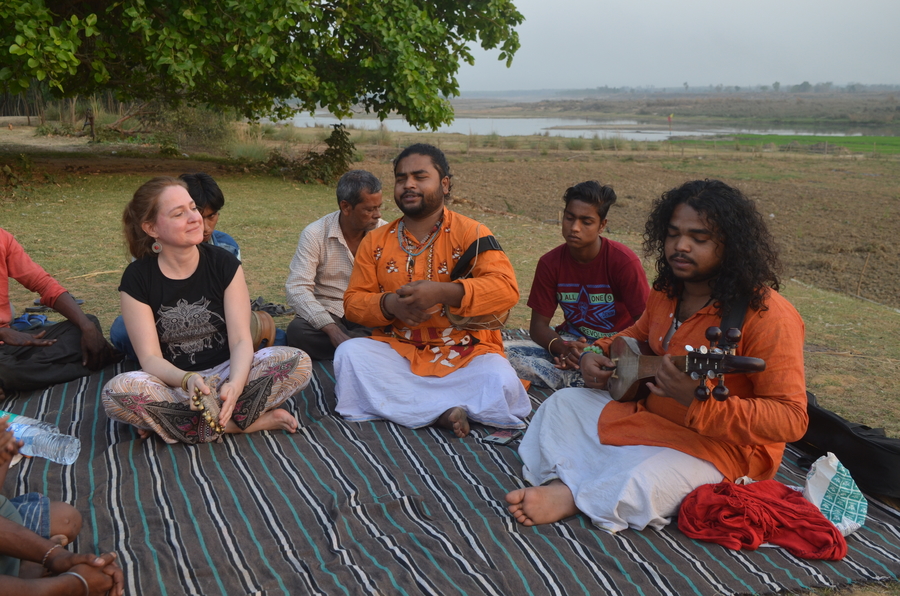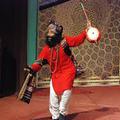Jamming with faqeers
I'm convinced that the term 'faqeer' (fakir, fakeer) needs some clarification here in Europe. What people associate it with is nothing more than a bed of nails, even though the issue is a bit more complicated. Unfortunately, even a google search would result in a majority of links related to asceticism.
I'm lucky enough to have heard a lot about musician faqeers on my wanders. In the case of faqeers, instrumental and vocal skills run in the family from generation to generation, and talent is paired with a performing style to which listeners attribute transcendental, even spiritual wisdom. Faqeers transmit a passionate love for life with much emotion and authenticity, through the channel of Baul poetry which cannot be separated from music itself. Of course, all of this can also become a mere routine, I have seen such examples. However, playing music with the Baul faqeer Das brothers was an experience for me that was so much more than a gesture of cultural diplomacy - it was a real 'feast'. The collaboration took place in Joydeb, West Bengal, and was organized by banglanatak dot com.
One just has to come to terms with the idea that in the far-away Eastern landscapes the seven beat as we know it is structured as 3/4, not 4/3. Having learned from my experiences in 2017, I came with a list of Hungarian folk songs in major scale, minor scale, or mixed variations, so that I would be able to find the right tune when the time came to respond to my partners' musical phrases.

In the course of these collaborations there is not an opportunity to prepare for the actual moment of sharing music. One must respond immediately to the other musician's playing. The random fusion that is thus originated, of course, cannot be compared to a composition, a work of art. It would be a mistake to evaluate it with the same means. This is rather a moment when one can experience the encounter of two cultures.
One of the brothers played a dotara (a small stringed instrument), while the other was strumming a percussion so far unknown to me, called khamak. It had a bulky, open drum body, with a string stretched out of it. As he kept changing the length of the string, the instrument made a uniquely mystical sound.
After a few minutes of faqeer music, the dotara player removed the rattle from his toe, and handed it to me. Finally we started our shared song, into which I 'smuggled' some Csángó Hungarian tunes. Experimenting with parlando-type melodies and forcing them onto the grid of rhythmical accompaniment would be in vain. It's a much better idea to throw in a song that the partners are able to follow, whose structure is easy to comprehend. After a while, we reached the moment when the dotara was more or less able to follow my singing, and what we got was - with a bit of an exaggeration - just as much Hungarian as it was Baul.
The result sounded something like this:
A retreat to Bhawaya land
The only thing that I find physically challenging in India is long train journeys. And in a state the size of West Bengal, you cannot get away with less than 10 hours of travelling if you want to reach landscapes where not only the climate, but the culture is also different.
I visited a place in the Darjeeling area, near the Nepali border - but Bhutan or China were also quite close. I felt a bit confused at the sight of ladies dressed in saris, but singing in a style and tone reminiscent of the Far East - even China. Although the dhol was also present here, the dominance of the stringed dotara recalled cooler, more Northern lands.
The Bhawaya – as they call themselves – sing in the Kamtapuri language, but they also speak Bengali and Hindi. I sat down with a Bhawaya group to pair three of their songs with Hungarian folk tunes. Again, I had to restructure the beat patterns a bit, but was pleased to hear that the scale was suitable to take in Trans-Danubian folk melodies. The Bhawaya artists - each one a soloist of their own - put their performing egos completely to the side, singing as a choir - and I responded to their music with Hungarian tunes.
As always, my flutes were with me from the five-hole kaval to the 'holeless' tilinkó. The Bhawaya flutist tried them each, and immediately formed a 'symbiosis' with my six-hole Gyimesi flute! It didn't bother him that he had to play it holding it the European way, rather than sideways. He played fantastically, even used it for the video shoot.
Here's how:
This collaboration project was also staged by banglanatak dot com.
Next I will share about my time in Pakistan... more short videos are constantly uploaded onto my facebook page.




